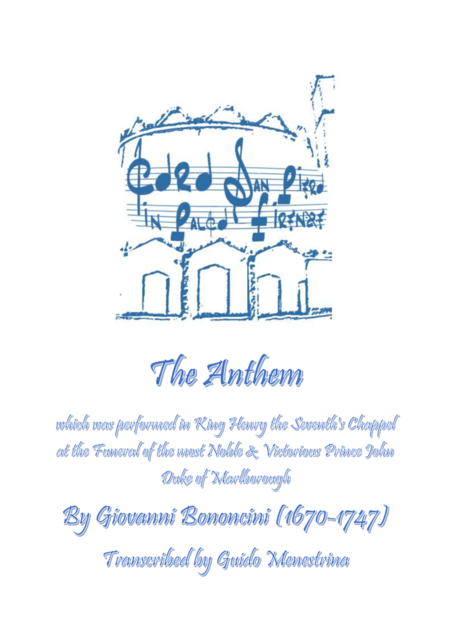Choral Choir (SATB) - Level 4 - Digital Download SKU: A0.828704 Composed by Giovanni Bononcini, Giovanni Battista Bononcini. Arranged by Guido Menestrina. Baroque,Contemporary,Sacred. Octavo. 44 pages. Guido Menestrina #368381. Published by Guido Menestrina (A0.828704). Anthem which was performed in King Henry the Seventh's Chappel at the Funeral of the most Noble & Victorious Prince John Duke of Marlborough By Giovanni Bononcini (1670-1747) transcribed by Guido Menestrina Il padre, Giovanni Maria Bononcini (Buononcini) (1642-1678), era stato violinista e compositore: attivo alla corte di Modena, aveva scritto un trattato, Musico prattico, pubblicato nel 1673. Il fratello minore di Giovanni, Antonio Maria, fu anch'egli musicista. Proprio dal padre Giovanni ricevette la prima educazione musicale; quando questi morì, nel 1678, divenne studente di Giovanni Paolo Colonna a Bologna, dove vennero eseguiti i suoi primi lavori. Proprio grazie al Colonna entrò a far parte dell'Accademia dei Filarmonici in veste di compositore. Nel 1685 aveva già preparato e pubblicato le sue prime opere. Ottenne nel 1688 il posto di musicista presso la basilica di San Petronio, e più tardi divenne maestro di cappella nella chiesa di San Giovanni in Monte. Sempre a Bologna fece la conoscenza del librettista Silvio Stampiglia, assieme al quale, tra il 1692 e il 1696, produrrà cinque opere. A partire dal 1692 si recò a Milano, Roma (dove fu apprezzato e sostenuto da Filippo II Colonna e dalla sua consorte Olimpia Pamphilj) e Venezia; infine, dal 1698 al 1711 si stabilì a Vienna, dove godette i favori degli imperatori Leopoldo I e Giuseppe I. Di passaggio a Berlino nel 1702, incontrò Georg Friedrich Händel, di quindici anni più giovane di lui, di cui riconobbe il talento precoce: lo avrebbe rincontrato alcuni anni più tardi. Dal 1714 al 1719 fu di nuovo a Roma, al servizio di Johann Wenzel, Conte di Gallas, Ambasciatore dell'Imperatore d'Austria a Roma, molto noto per il suo amore per la musica. Al Conte di Gallas, Bononcini dedicò la Favola Pastorale Erminia, rappresentata al Teatro della Pace nella Stagione del Carnevale del 1719. Il dramma musicale ebbe grandissimo successo sia per la musica, sia per gli interpreti, fra cui si segnalarono Domenico Gizzi (1687-1758), Musico Soprano della Real Cappella di Napoli ed il celebre contralto napoletano Francesco Vitale. Sempre nella Stagione del Carnevale 1719 al Teatro della Pace, Bononcini rappresentò il dramma per musica L'Etearco, dal librettista Silvio Stampiglia dedicato alla Contessa Ernestina di Gallas, moglie dell'Ambasciatore austriaco. Anche in questo dramma per musica Domenico Gizzi e Francesco Vitale fecero apprezzare tutte le spezie più ricercate del virtuosismo canoro. Poi, dal 1720 si stabilì a Londra, sotto la protezione del John Churchill, I duca di Marlborough. Qui si esibì anche al violoncello in numerosi concerti, molto apprezzati dall'aristocrazia inglese. Divenne membro della prestigiosa Royal Academy of Music.[senza fonte] Il pubblico londinese era, all'epoca, totalmente ignorante dell'opera italiana, e Händel stava muovendo i primi passi della sua prestigiosa carriera. Fra i due compositori si accese un forte spirito di competizione, sia che collaborassero alla realizzazione della medesima impresa (i tre atti dell'opera Muzio Scevola furono composti il primo da Filippo Amadi, il secondo da Bononcini, il terzo da Händel, al fine di soddisfare tutti e tre gli artisti), sia che, più spesso, si impegnassero in produzioni rivali. Le opere di maggior successo di Bononcini in quegli anni furono Astarto (1720), Crispo (1722), Griselda (1722), che si rivelò un vero e proprio trionfo, Erminia (1723), Calfurnia (1724). A favore dell'italiano era anche una certa ostilità verso Händel dovuta alle sue origini tedesche e alla contemporanea presenza sul trono inglese della poco amata dinastia di Hannover. Ma nel 1727-1728 scoppiò uno scandalo che compromise il successo di Bononcini e lo costrinse a lasciare Londra: il compositore Antonio Lotti accusò il madrigale di Bononcini In una siepe ombrosa di essere un plagio di un brano dei suoi Duetti, terzetti e madrigali. Fuggito a Parigi nel 1733, a causa di speculazion.
